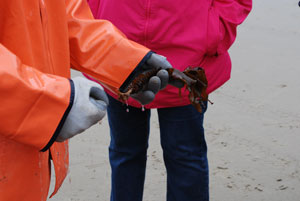Japanese Tsunami Debris and Potential Invasions In Western North America
By Chris Janousek, Melanie Frazier, Henry Lee II

A large floating dock from Japan recently washed up on the Oregon coast, bringing a host of non-native species with it.
When the earthquake and tsunami hit Japan’s coast on March 11, 2011 it resulted in the loss of nearly 20,000 lives and billions of dollars in damage. One result of this devastation was an estimated 25 million tons of debris, much of which was swept into the Pacific Ocean as the tsunami receded. The refuse that did not sink formed a floating field that scientists predicted would arrive on the North American coastline in 2013.
One surprising early arrival was a large floating dock that washed ashore June 5, 2012 on Agate Beach, about five miles north of our EPA research lab in Newport, Oregon.
The dock, about the size of four large rental trucks (roughly 20 meters long and six meters wide), was covered with organisms not native to North America, including sea stars, barnacles, mussels, amphipods, and algae.
One organism of particular concern was a ruffled kelp, Undaria pinnatifida. The species, also known as ‘wakame,’ is a seaweed used in Japanese soups and salads, and is also classified as one of the world’s top 100 worst invasive species by the Global Invasive Species Database. Undaria has not become established in the Pacific Northwest, but has invaded coastal waters in California.
Invasive species are one part of EPA’s effort to understand threats to natural ecosystems. Along with partners from the U.S. Geological Survey, we are building an “Atlas of Nonindigenous Marine Species in the North Pacific” to catalog marine and estuarine invaders in the U.S., Canada, and Asia.
The Atlas will help risk managers assess the likelihood of new invasions by geographic location and species. This type of information will be an invaluable resource for monitoring the arrival of invasive species from Japan or other parts of the world.
While the dock represents an unusual threat to the outer coast and estuarine ecosystems of the Pacific Northwest, the degree of risk depends to a large extent on the specific Japanese species transported and whether they have already invaded the U.S. west coast.
Most marine invaders are introduced into new areas of the world’s coastline by ballast water discharged from ships or by transport on boat hulls. The Japanese dock demonstrates that debris from last year’s tsunami may be a significant additional way for non-native species to arrive in North America during the next couple years.
About the authors: Ecologists Chris Janousek, Ph.D., Melanie Frazier, Ph.D., and Henry Lee II, Ph.D., study the current status and stressors of coastal ecosystems. All three work at EPA’s Western Ecology Division laboratory in Newport, Oregon.
Editor's Note: The opinions expressed in Greenversations are those of the author. They do not reflect EPA policy, endorsement, or action, and EPA does not verify the accuracy or science of the contents of the blog.



We Must Submit……..
Thanks to The Scientists who discovered all of natural phenomenon and so made us to believe it that how the species exist.-